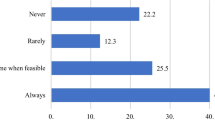Abstract
Introduction
Smartphones have revolutionised our demands for constant access to information. The usage of smartphones in the clinical setting is becoming widespread. The aim of our study was to assess smartphone ownership and usage across a cohort of interns.
Methods
A voluntary novel questionnaire was distributed to interns in two university hospitals. Details regarding smartphone ownership and usage were assessed. Likert scales were utilised for analysis.
Results
Sixty-one (74.4 %) interns responded to the survey. Sixty (98.4 %) owned a smartphone with iPhone® being the most popular (76.7 %). Fifty-five (91.6 %) interns have downloaded medical applications (‘apps’), while 29 (52.3 %) reported paying for them. Regarding smartphone use on-call, 30 (50 %) interns agreed it aids diagnoses, 26 (43 %) agree it helped in interpreting laboratory values, 31 (51.7 %) agreed it helped in dosing of medication and 33 (55 %) agreed it was of assistance in medical emergency protocols. Forty-two (70 %), 42 (70 %) and 46 (76.7 %) interns agreed or strongly agreed smartphones have a positive influence on them in terms of levels of stress, confidence and level of knowledge, respectively.
Conclusion
Smartphone usage is widespread among our intern cohort. The introduction of hospital applications with local guidelines would be welcomed; however, this may require informed patient consent regarding their use.


Similar content being viewed by others
References
Franko OI, Tirrell TF (2012) Smartphone app use among medical providers in ACGME training programs. J Med Syst 36(5):3135–3139
http://www.apple.com/uk/iphone/from-the-app-store/. Accessed 5 Sep 2013
Boulos MN, Wheeler S, Tavares C, Jones R (2011) How smartphones are changing the face of mobile and participatory healthcare: an overview, with example from eCAALYX. Biomed Eng Online 10:24
Visvanathan A, Hamilton A, Brady RR (2012) Smartphone apps in microbiology—is better regulation required? Clin Microbiol Infect 18(7):E218–E220
O’Neill S, Brady RR (2012) Colorectal smartphone apps: opportunities and risks. Colorectal Dis 14(9):e530–e534
Franko OI (2011) Smartphone apps for orthopaedic surgeons. Clin Orthop Relat Res 469(7):2042–2048
Carter T, O’Neill S, Johns N, Brady RR (2013) Contemporary Vascular Smartphone Medical Applications. Ann Vasc Surg 27(6):804–809
Choi BG, Mukherjee M, Dala P et al (2011) Interpretation of remotely downloaded pocket-size cardiac ultrasound images on a web-enabled smartphone: validation against workstation evaluation. J Am Soc Echocardiogr 24(12):1325–1330
Abboudi H, Amin K (2011) Smartphone applications for the urology trainee. BJU Int. 108(9):1371–1373
Shaw M, Adam CJ, Izatt MT, Licina P, Aslin GN (2012) Use of the iPhone for Cobb angle measurement in scoliosis. Eur Spine J 21(6):1062–1068
El-Gayar O, Timsina P, Nawar N, Eid W (2013) Mobile applications for diabetes self-management: status and potential. J Diabetes Sci Technol. 7(1):247–262
Dayer L, Heldenbrand S, Anderson P, Gubbins PO, Martin BC (2013) Smartphone medication adherence apps: potential benefits to patients and providers. J Am Pharm Assoc (2003) 53(2):172–181
Lindquist AM, Johansson PE, Petersson GI, Saveman BI, Nilsson GC (2008) The use of the personal digital assistant (PDA) among personnel and students in health care: a review. J Med Internet Res 10(4):e31
Prgomet M, Georgiou A, Westbrook JI (2009) The impact of mobile handheld technology on hospital Physicians’ work practices and patient care: a systematic review. J Am Med Inform Assoc 16(6):792–801
Wu R, Morra D, Quan S et al (2010) The use of smartphones for clinical communication on internal medicine wards. J Hosp Med. 5(9):553–559
Payne KB, Wharrad H, Watts K (2012) Smartphone and medical related App use among medical students and junior doctors in the United Kingdom (UK): a regional survey. BMC Med Inform Decis Mak 30(12):121
Choi JS, Yi B, Park JH, Choi K et al (2011) The uses of the smartphone for doctors: an empirical study from samsung medical center. Healthc Inform Res. 17(2):131–138
Lakdawala N, Fontanella D, Grant-Kels J (2012) Ethical considerations in dermatologic photography. Clin Dermatol 30:486–491
Kunde L, McMeniman E, Parker M (2013) Clinical photography in dermatology: ethical and medico-legal considerations in the age of digital and smartphone technology. Australas J Dermatol 54(3):192–197
Times IB., FDA Drafting Guidelines, Seeks Comments on Medical Apps. http://www.ibtimes.com/articles/185387/20110722/mobile-apps-fda-proposes-guidelines-regulate-medical-health-apps-iphones-ipads-devices.htm. Accessed 5 Sep 2013
Acknowledgments
No source of funding, financial or otherwise.
Conflict of interest
None.
Author information
Authors and Affiliations
Corresponding author
Rights and permissions
About this article
Cite this article
O’Reilly, M.K., Nason, G.J., Liddy, S. et al. DOCSS: doctors on-call smartphone study. Ir J Med Sci 183, 573–577 (2014). https://doi.org/10.1007/s11845-013-1053-4
Received:
Accepted:
Published:
Issue Date:
DOI: https://doi.org/10.1007/s11845-013-1053-4



